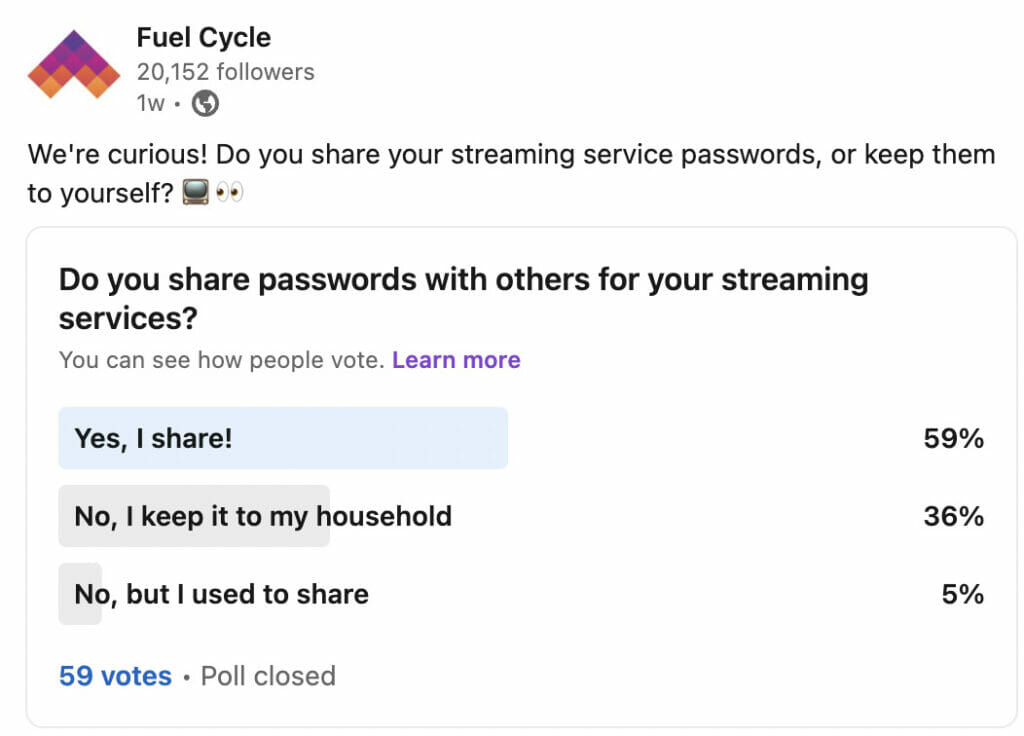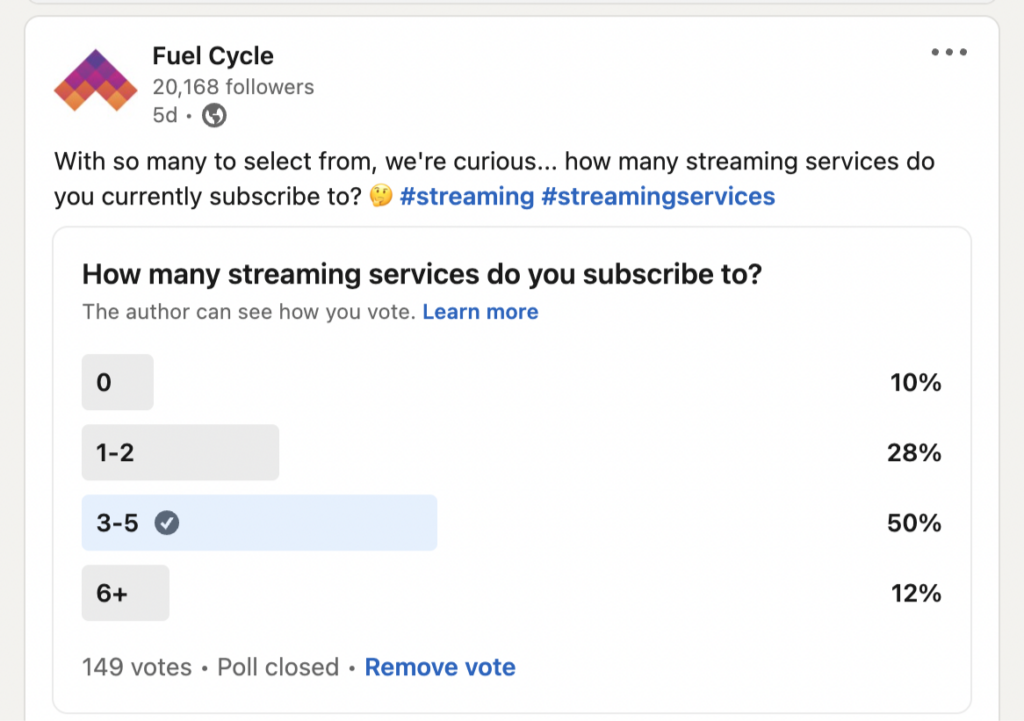Ahh, the streaming wars. Initially promised as an answer to expensive and complicated cable TV plans, streaming services created an entertainment renaissance. Netflix, previously a DVD mail-order business, emerged as the forerunner with an add-free, under $10 service. Now, another change is upon the home entertainment landscape due to a proliferation of streaming services, tiered pricing, and a crackdown on password sharing. Netflix defines password sharing as “splitting a login with anyone who doesn’t live full-time at the same address”. For more on the pros and cons of streaming, read our blog “Market Research Pain Points—Media and Entertainment”.
In this blog, we examine the streaming entertainment landscape in 2022 and present research submitted by YOU on our social polls.
Results
Our first poll asked the hot-button question: Do you share passwords with others for your streaming services?

A total of 59 people voted. 34.81 people, or 59%, share passwords. 20.06 people, or 36%, keep it to their households. 2.95 people, or 5%, used to share passwords but no longer do so. The highest number of votes went to the “Yes, I share!” option.
Then, we asked how many streaming services respondents currently subscribed to.

There were 149 total votes. 14.9 people, 10%, do not currently subscribe to any streaming service. 41.72 people, 28%, subscribe to one or two streaming services. The highest number of people subscribe to 3-5 streaming services, coming in at 74.5 people or 50%.
Finally, we asked how much money people spent on streaming services per month.

157 people voted between four categories. 9.42 people, or 6%, paid zero dollars a month for streaming services. 26.69 people, 17%, paid between $1 and $15 a month. 48.67 people, 31% pay between $16 and $25. 72.22, 46%, pay more than $26 a month. The highest number of people pay more than $26 a month for their streaming services.
Analysis
Voters in these polls subscribe to a handful of services, pay $26 or more monthly, and are likely to share passwords. Now, let’s observe how these trends play out in the world.
Sharing Passwords
Password sharing is common. According to Netflix, approximately 100 million people are using the popular streaming service without an account. Cybersecurity firm 1Password estimates that almost half of Gen Z and a quarter of millennials share streaming passwords with their parents.
Netflix is testing password-sharing fees in Chile, Costa Rica, and Peru. It’s highly likely that they will begin doing so in the United States in early 2023. The program charges users for subaccounts outside of their household, with each subaccount costing $3-$5. Netflix will track users’ IP addresses to enforce password-sharing penalties; if the algorithm shows that an account is frequently accessed by a subaccount outside of the home IP address, Netflix will ask for the primary account owner to verify the activity.
While password sharing cuts profits at streaming companies, it also presents a security risk. Security company Beyond Identity surveyed one thousand people and found that over a third used the same password for every streaming service. This makes their accounts more vulnerable to hacking, putting them at a greater risk of identity theft and compromised financial information. Another concern is password sharing with third parties without the consent of the account owner.
Number of Streaming Services
Forbes reports that there are nearly 50 streaming entertainment services available in North America. Netflix lost subscribers for the first time in a decade during the first half of 2022. However, they had some of the most popular shows this year with Stranger Things season 4 and Wednesday.
Cost per Streaming Services
According to The Washington Post, subscribing to the top eight entertainment streaming services costs $60 a month. Subscription prices are rising across the board. Disney+, AppleTV, Hulu, and Netflix have all increased their prices in 2022. More companies are bringing back advertisements to offset profit loss while providing budget options to subscribers. This graphic from Reelgood shows the cost of add-free plans from the top services:
Fuel Cycle Solutions
The Fuel Cycle ecosystem of solutions is the way to support market research initiatives. The Media and Entertainment brands that scale their research and aggregate a consistent stream of customer feedback into an actionable decision-making process will have a leg up. This can be accomplished through online communities, panels, and custom research solutions catered to fit the needs of the Media and Entertainment industry. MR via online research communities can produce the insights necessary to drive product growth and manage the customer experience. In-home usage testing, focus groups, and in-depth interviews are vital to innovating the right way. Request a demo today.
While viewers get hyped for the new season, brands can capitalize on that same excitement. Streaming media companies will find value in Fuel Cycle Exchange apps like FCX Affectiva, FCX Course5, and FCX Pilot.ly. FCX Pilot.ly is an online research platform that makes it possible to securely screen content to your target audience to rapidly gather feedback. FCX Affectiva is an emotion recognition software that allows you to gain insight into unfiltered and unbiased emotional responses to digital content. The results are aggregated in a dashboard, allowing you to measure key emotion metrics such as joy, surprise, or contempt at important scenes.
Fuel Cycle Ignition is a suite of research automation tools backed by scientific methodologies. Put these tools to work for you with apps like Concept/Creative Screening. Concept & creative screening allows you to assess the potential of new ideas early on in their development stage. By capturing real-time feedback on your concept from existing and potential customers, you can quickly evaluate its strengths and weaknesses. Focus your resources on the ideas with the most potential, while saving time and money on de-prioritizing the ones that are less likely to be successful.
Feel more like reading than marathoning through a season of TV? We’ve got you covered with our other streaming topics. The Fuel Cycle team analyzes McKinsey research about streaming during the pandemic in “How COVID-19 Has Impacted Consumer Behavior”. Market researchers can glean insights about branding, as detailed in “What the Science of Binge Watching Can Teach You about Brand-Produced Content”. Finally, here from legacy broadcasting company CBS reflect on media consumption in 2020 in the webinar, “2021 Playbook for Media and Entertainment—Featuring Original Media Consumption Insights from CBS”.



